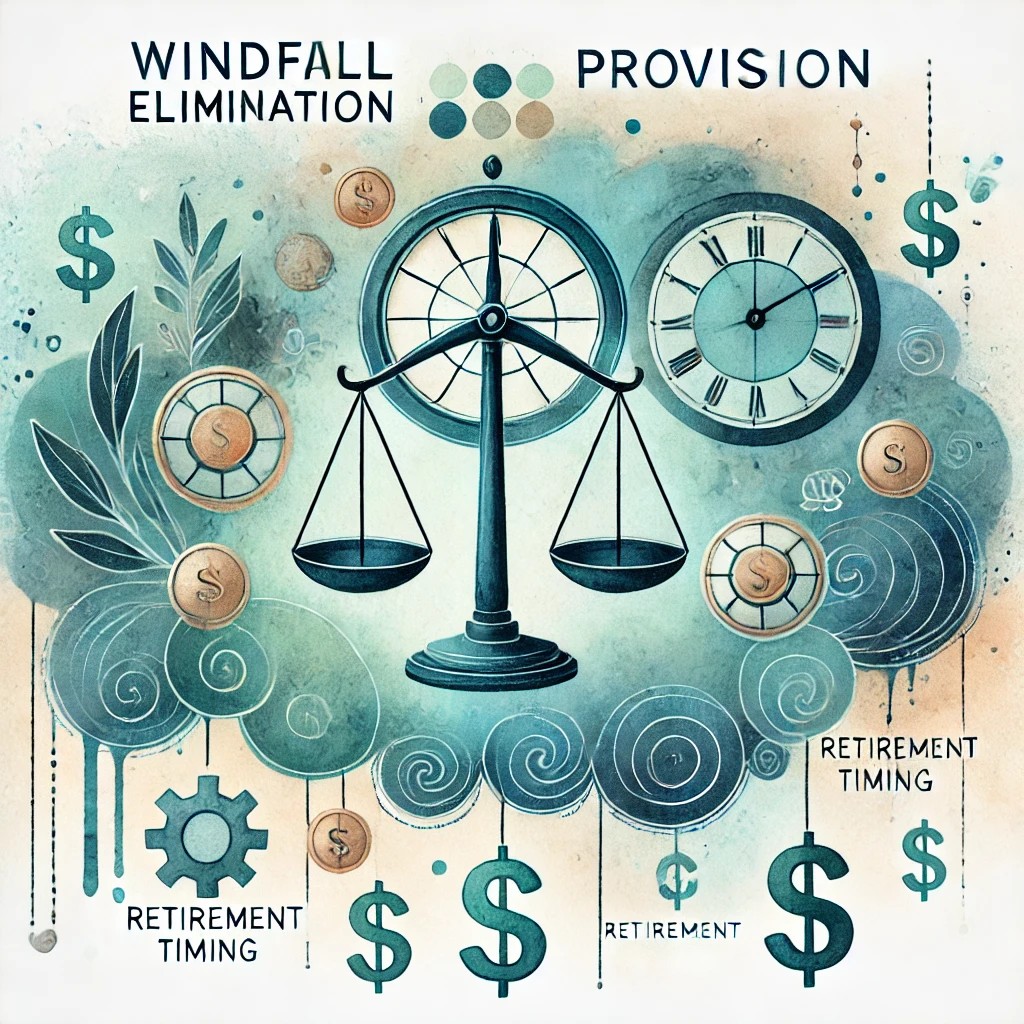The Windfall Elimination Provision (WEP) is a subject of heated debate in the United States, affecting the Social Security benefits of many individuals who have worked in both the public and private sectors, or in foreign countries with earnings based public pensions such as CPP in Canada.
With the recent passage of the Social Security Fairness Act by both houses of Congress, the future of the WEP hangs in the balance, awaiting President Biden’s signature. Let’s break down what the WEP is, why it exists, and explore the arguments for and against its repeal.
 alt="Windfall Elimination Provision" width="1024" height="1024" />
alt="Windfall Elimination Provision" width="1024" height="1024" />What Is the Windfall Elimination Provision?
The WEP is a formula used to adjust Social Security benefits for individuals who have pensions from employment not covered by Social Security, such as many state and local government jobs, and some foreign pensions. The provision aims to prevent what some see as a “windfall” for workers who might otherwise receive disproportionately high benefits due to their combined earnings from Social Security-covered and non-covered employment.
The Social Security Totalization Agreement allows Canadians with less than 40 quarters of Social Security earnings history to qualify for Social Security benefits based on your years working and contributing to the Canada Pension Plan (CPP) in Canada.
Your earnings and CPP contributions do not count toward determining your Social Security benefit, but your years of working in Canada will count toward the required 40 quarters to qualify for Social Security benefits. Your actual Social Security benefit will be based on your U.S. earning subject to FICA taxes.
How Does WEP Work?
The WEP modifies the formula used to calculate Social Security benefits. Social Security benefits are calculated by applying three different percentages to a person’s lifetime average indexed monthly earnings (AIME) and adding them up to obtain the worker’s monthly benefit (primary insurance amount (PIA)) at full retirement age. For most beneficiaries in 2024, the PIA equals the sum of:
- 90 percent of the first $1,174 of AIME, plus
- 32 percent of AIME over $1,174 and through $7,078, plus
- 15 percent of AIME over $7,078.
The WEP PIA replicates the regular PIA but scales down the first percentage from 90 percent to 40 percent in increments of five percentage points per year for workers with less than 30 years of coverage (YOCs).
Thus, workers with 30 or more YOCs have a first PIA factor of 90 percent, including those that would otherwise be subject to the WEP or have Canadian earnings history. Workers with 21–29 YOCs have a first PIA factor between 45–85 percent, and workers with 20 YOCs have a first PIA factor of 40 percent.
| YOC | % AIME |
| 30 | 90 |
| 29 | 85 |
| 28 | 80 |
| 27 | 75 |
| 26 | 70 |
| 25 | 65 |
| 24 | 60 |
| 23 | 55 |
| 22 | 50 |
| 21 | 45 |
| 20 | 40 |
The reduction cannot exceed half of the individual’s government pension from non-Social Security-covered employment.
Why Does WEP Exist?
The WEP was introduced in 1983 to address concerns that the standard Social Security formula overestimates benefits for workers with mixed earnings records.
Without the WEP, individuals with short careers in Social Security-covered jobs could receive benefits as if they were lower-income workers, even if they had substantial pensions from non-covered employment.
Since earnings are averaged and do not include uncovered pensions, people who worked part-time along with, or for a limited number of years after, their Social Security-exempt employment receive a Social Security benefit that is a larger percentage of their overall employment earnings because of the way Social Security credits a larger percentage to lower earnings levels and provides a larger proportional benefit to lower income earners.
The Social Security Fairness Act: A Turning Point
The Social Security Fairness Act, recently passed by Congress, seeks to repeal both the WEP and the Government Pension Offset (GPO). Advocates of the repeal argue that these provisions unfairly penalize public servants, such as teachers, police officers, and firefighters, who have devoted their careers to serving the public.
Positions of President Biden and President-Elect Trump
President Biden
President Biden has previously expressed support for reforming the WEP to make it fairer. While not explicitly endorsing full repeal during his presidency, he has recognized the hardships it imposes on public workers. His decision on signing the repeal bill is eagerly anticipated.
President-Elect Donald Trump
Donald Trump has not yet issued an official statement on the WEP repeal but has historically taken positions that resonate with concerns about the financial sustainability of Social Security. On December 17, 2024, The Fraternal Order of Police (FOP) released a letter describing a recent meeting with President-elect Donald Trump on December 16.
The FOP reports that President-elect Trump supports a full repeal of the Windfall Elimination Provision (WEP) and Government Pension Offset (GPO). Observers speculate that he might oppose the repeal on fiscal grounds while appealing to affected voters by advocating for targeted reforms.
Arguments in Favor of WEP Repeal
- Fairness to Public Servants: Advocates argue that the WEP unfairly reduces benefits for individuals who paid into Social Security and earned pensions from public service.
- Simplification: Repealing the WEP would simplify the Social Security system, reducing confusion and administrative burdens.
- Addressing Inequities: Critics of the WEP point out that it disproportionately impacts lower-income retirees, exacerbating financial challenges for vulnerable populations.
Arguments Against Repealing the Windfall Elimination Provision
The Windfall Elimination Provision (WEP) affects how Social Security benefits are calculated for people who also receive a pension from work not covered by Social Security. Some argue against repealing the WEP for several reasons.
First, repealing the Windfall Elimination Provision would increase costs for Social Security. This could speed up the depletion of the Social Security trust fund, risking its long-term stability.
Second, supporters say the Windfall Elimination Provision helps keep the system fair. It prevents people with dual retirement incomes from getting an unfair advantage. Those affected by the WEP still get a pension from their non-Social Security job, so their Social Security benefit is reduced to balance this. Without the WEP, retirees with both pensions might receive more than those relying only on Social Security.
Finally, opponents believe fixing Windfall Elimination Provision inequalities should not threaten Social Security’s financial health. They stress the importance of fiscal responsibility to keep the program sustainable for future generations.
Understanding the Windfall Elimination Provision helps clarify why some oppose its repeal despite concerns about fairness.
What Do You Think?
The debate over the Windfall Elimination Provision touches on core issues of fairness, fiscal responsibility, and the role of Social Security in supporting retirees.
As the nation awaits President Biden’s decision, we invite you to share your thoughts. Do you believe repealing the WEP is the right move, or do you think it’s necessary to maintain the provision to protect Social Security’s future?
Let us know your perspective in the comments below!
Frequently Asked Questions
What is the Windfall Elimination Provision and how does it affect Social Security benefits?
The Windfall Elimination Provision (WEP) impacts the Social Security benefits of workers who also receive a pension from jobs not covered by Social Security. It modifies the standard benefit formula, which may reduce your benefits. You can find more details on the Social Security Administration’s WEP page.
What are the eligibility requirements for the Windfall Elimination Provision?
To be affected by the WEP, you need to work in a job that doesn’t contribute to Social Security, often found in certain government positions. If you receive a pension from such a job and also qualify for Social Security, WEP may apply. More information can be found on the NEA’s FAQs about WEP.
How is the Windfall Elimination Provision calculated?
WEP uses a different formula to calculate your Social Security benefits. It considers the number of years you paid Social Security taxes and the amount of your non-covered pension. Exact calculations involve determining the “substantial earnings” and applying a revised benefit formula. The SSA’s explanation provides a detailed overview.
Can the Windfall Elimination Provision reduce my Social Security benefits if I receive a public pension?
Yes, if you receive a public pension from work not covered by Social Security, the WEP can reduce your benefits. The reduction depends on several factors, including your earnings history and the size of your pension. See more about this on the SSA’s WEP page.
Are there specific states exempt from the Windfall Elimination Provision, or does it apply nationwide?
The WEP applies across all states in the U.S. There is no state exemption because the provision is based on federal law, affecting those with pensions from jobs not covered by Social Security. Further reading is available at the SSA website.
Is there any legislation in progress that aims to repeal the Windfall Elimination Provision?
Yes, the Social Security Fairness Act aims to repeal the WEP and Government Pension Offset provisions. As of January 2025, this legislation has been signed into law by President Biden, eliminating these provisions. More coverage on this is explained in Equable’s FAQ.



